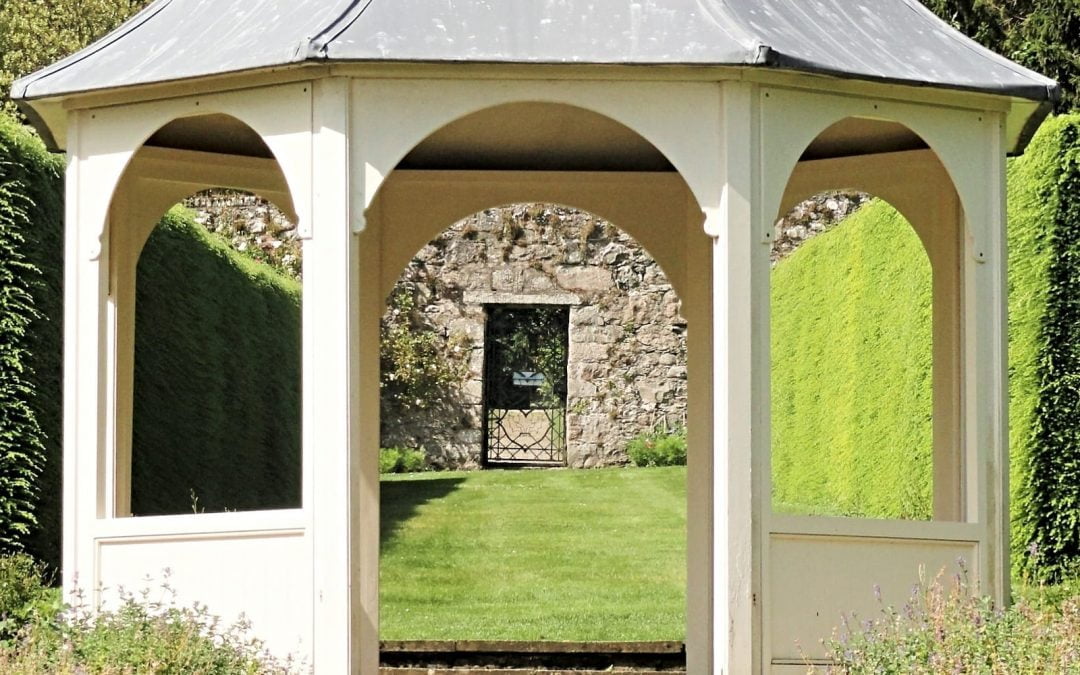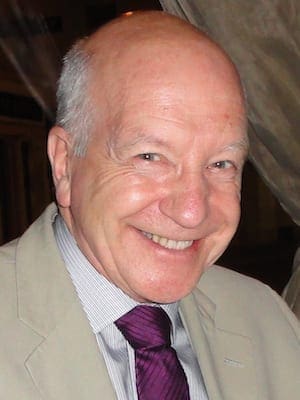Standing in the grass lane between two high hedges.
On the right, and on the other side of the hedge, the 18th century rose garden. On the left, and over the hedge, is the 17th century rose garden.
Between them, this motorway of manicured grass, and at the intersection, the crossroads of paths, this summerhouse with neither glass in the windows nor doors in the frames. It is a building open to whoever wants to enter.
At the end of the path, in both directions, there are walls; it is, after all, a walled garden. But in the wall, in the distance, a gate. So not the wall of a fortress, but a garden wall, a sheltering wall.
The balance of open and enclosed, the symmetry of windows and doors, produced one of those important moments of insight that demand later reflection.
At the time, I felt the aesthetic impact of open doors and windows, a clear inviting path, sheltering walls and high hedges and an unlocked gate.
But I took the photo because the harmony of shape, light and evocative metaphor was demanding more of me than aesthetic appreciation and joy in perceived beauty.
On the warmest, sunniest day of the year so far, enjoying an ancient garden filled with old roses and laid out in the garden geometry of previous centuries, I glimpsed some of the most important metaphors in the moral grammar book.
For walls, read borders. In the current cultural climate in the United Kingdom, our government is busy constructing and defending legal and administrative guidelines to narrow the gates of entry to our country.
At the same time within those walls / borders, policies are developed with the intention of creating a “hostile environment” for illegal immigrants; the problem with this is that an environment is pervasive, inescapable, it is where people live and move and have their being.
The hostile environment affects everyone who has to breathe the cultural air. It means those who rightfully have their homes in our midst have to prove they have a right to live among us and to stay here.
And the gate is being deliberately narrowed. Hostility is seldom an improvement in a culture’s ecology.
That summerhouse with open doors and limited space within. The global pressures on people whose lives have become intolerable are not going to recede because we build bigger walls, make the gates increasingly narrow and make it known there is no welcome here.
Openness is an important moral metaphor in my own ethical syntax. Those open doors and windows, and that broad path of tended grass between two high hedges, argue a generosity that contradicts narrow gates and high walls and the whole mindset that sees the “other” as threat.
The aesthetics of the photo seemed to require appreciation of uninterrupted geometry, symmetry and balance. The only person present, and he is invisible, is the photographer.
Would the presence of people “waste” the picture? Aren’t gardens human creations, for human enjoyment, and however beautiful and manicured, don’t they remain sterile and incomplete without a human presence?
Is there a danger that, in wanting the garden for ourselves, the whole hostile environment mindset is less about controlling borders and managing immigration, and more an exercise in exclusion of those who are “other” and “different” and whose presence is perceived to “waste the picture”?
Of course, borders are an essential political reality. And yes, immigration must be managed in ways that maintain social stability.
The challenge is how to do this in a global, multicultural world going through one of the most disruptive periods in recent human history, especially for people in the less resourced and developed parts of the world.
In the photo. one hedge is in shadow, the other in sunlight; earlier that day it was the other way ’round. Time passes; history is fluid; human experience changes and adapts in the attempt to live together, to build peace and cooperation, to plan a future that includes all of us.
There is a quite subtle but ultimately significant difference between optimism and hopefulness, at least as I experience and understand those words.
Optimism is less well founded in reality and human intention than hopefulness. Optimism more easily dissolves into wishful thinking. Hopefulness is more about worldview, mindset and core conviction.
For me, as a Christian, I see the world as a place where resurrection happened. In human history, in a garden in the early morning, the life of God blazed out of the bleakest blackness with a “yes” that reverberates through space and time, to this day and tomorrow.
John Bell says something like that in his Easter hymn:
“In a garden, just at dawn,
Near the grave of human violence,
The most precious Word of Life
Cleared his throat and ended silence,
For the good of us all.”
It is hard to be open to the future if we are closed to people who are other than ourselves.
It is impossible to build peace with the materials of a hostile environment.
We cannot build a better future with higher walls, narrower gates and paranoia about who walks into our photos and wastes the harmony and symmetry of our comfort zones.
As a follower of Jesus, I remain hopeful, but not passive. There is in Christian hope a note, a tone, of defiance.
Christian hope is biased, leaning toward justice, tilted into whatever makes for peace, weighted toward reconciliation as the eternally preferred ”modus operandi” of God in Christ.
Look at the photo again. The red rose intruding on a scene dominated by greens and white.
It is incongruous, out of place, and could easily be edited out. But no. It is there as a protest and a presence, as a reminder and a reason to be hopeful.
The flower and color of love celebrate a world where resurrection happened, where reconciliation is God’s categorical imperative, and where the Christian vision culminates in the most inclusive scene of the Bible:
“I looked, and there before me was a great multitude that no one could count, from every nation, tribe, people and language, standing before the throne and before the Lamb. They were wearing white robes and were holding palm branches in their hands” (Revelation 7:9).
Editor’s note: A version of this article first appeared on Gordon’s blog, Living Wittily. It is used with permission.
Part-time minister of Montrose Baptist Church in Angus, Scotland, and the former principal of the Scottish Baptist College. He is on the advisory board of the Centre for Ministry Studies, University of Aberdeen, and is honorary lecturer in the School of Divinity, History and Philosophy.


